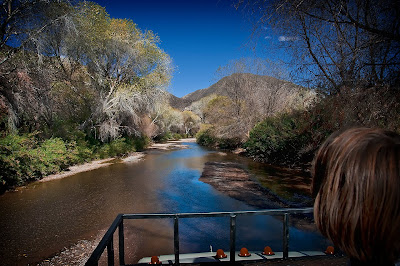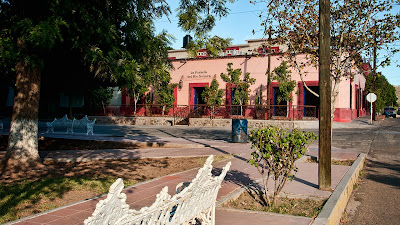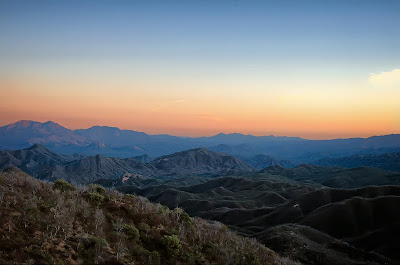The Rio Sonora Valley
Recently we spent a week in a somewhat remote area in northern Mexico known as the Rio Sonora Valley. It has little to do with the Mexico most people imagine, there are no Margaritas, chips and salsa and the violence that has plagued many of the border cities seems far removed. Until the 1970s, when a paved road was constructed, the upper and middle Rio Sonora Valley remained mostly isolated with a subsistence economy.
“What good does it do us? (The high rainfall of that summer.) Once we grew wheat, and we took it to the mill at El Bagote, where they ground it for us. The flour was fresh and wholesome; it came from our fields; there was enough for everybody. Now, we have no mill. If we grow wheat, the CONASUPO buys it all. In return, they send us last year’s flour, full of bugs and costing sixty pesos a kilo. We can barely afford to buy it. I have six children to feed. There’s no work for the men.â€
The old mill at Banamichi, Sonora.
Despite the changes brought by the road, there is something about the Rio Sonora Valley that is captivating. It is a place to which we frequently return. Some of that has to do with the fact that the blood of the people who inhabit that area flows in my veins. My grandfather, the son of a French adventurer/soldier who had come to Mexico, was born in one of the small towns along the River called Banamichi, which in the language of the Opata, the original inhabitants of the area, means “where the river turns.†The other reasons we return ranges from the beauty of the landscape and geography; the way of life that still has remnants of a subsistence economy not too far in the distant past; and like most captivating places – the local foods and Sonora’s classic mescal Bacanora. Perhaps what attracts us the most is that life is still simpler there, less dependent on machines, animals are still used to work the land, it just feels good to be there.
Unique about the Rio Sonora is that it is difficult to find a river in the southwestern part of North America that hasn’t gone dry due to the overdraft of groundwater, isn’t deeply eroded and still has the capacity to sustain the lives of the people who live along it. For this part of the world, that is rare.
Fields and bajadas along the river.
A number of towns along the river have missions dating back to the 1600s. Unlike many parts of Mexico, the Catholic church is still central to the people’s lives. The way of life might be described as a “cultura ganadera,†a culture that for the most part is centered on cattle. And yet, the line that typically divides cowboys and farmers is totally blurred, the people of the Rio Sonora don’t distinguish between the two. They are one and the same.
The mission at Aconchi, Sonora. The town was founded in the early 1600s and presumably the mission around the same time.
Horses still remain a part of everyday life.
This year we were fortunate to receive a small grant that will allow us to photograph life along the River. It is modest, but enough to get us fully invested to the point we can’t give it up. Our focus is to capture vestiges of the older disappearing lifestyle and at the same time, document the modern changes that are taking place. We began this past December and will continue throughout the different seasons of the year. Our base is the town of Banamichi, where we are being provided lodging by Bill Harmsen and his wife Irma, at their lovely hotel, La Posada del Rio Sonora – www.laposadadelriosonora.com. The eventual use of the photos has yet to be determined. All the usual options are possible, a book, websites and the like. It allows for a great amount of photographic freedom in a place overflowing with beautiful imagery. In the spirit of the words of the old classic black and white photographer Henri Cartier Bresson, it’s an easy place to get “one’s head, eye and heart on the same axis.â€
La Posada on the Banamichi plaza.
During the course of the year we’ll make additional posts about our travels in the area. Most likely, they will mainly be comprised of photos, keeping writing to a minimum. I really don’t enjoy being in the position of trying to write about an area where I really know little of the history, culture and geography. There are certainly people much more capable than I. However, what I will do is to give you our impressions of the places we visit, and the people we meet. That I can do.
The Maldonados of La Estancia, Sonora.
Before posting any photos I should tell you a little about the landscape. Basically it’s a transition zone between the Sierra Madre of Chihuahua and the coastal plain of the Sonoran Desert. The Sonora River Valley consists of narrow floodplains ranging from 1 km to about 4 km in width. It is flanked by mountains on both sides and bordered by what are called bajadas, alluvial deposits dissected by dry river beds known as arroyos, that overlook the floodplain and are typically where towns and settlements are located. These are also what many people in this part of the world refer to as mesas. The middle and upper Valley, which is the area of our concern, consists of Sonoran Desert vegetation at the lower elevations and oak grasslands, like the area where we live, in the upper regions. Winters are mild, frost is rare in the middle section of the Valley, two unpredictable rainy seasons are the norm – the equipatas of the winter and the monsoon driven las aguas that begin the end of June and continue through the month of August.
The website for the valley gives a good overview of the towns and their facilities. //www.riosonora.com/index.html
Overlooking the Valley from the mountains above Baviacora, Sonora.
Hopefully, through these posts, we will share a little of this special place and it’s people that continues to capture our hearts and so joyfully enrich our lives.
Our son Kalin with bike riding the the roads amongst the fields of Banamichi.
Beautiful paper thin “tortillas grandes,” being made in a backyard in Ojo de Agua, Sonora.
“Taqueria” at the recent town fiesta of Baviacora, Sonora.












Thanks for giving a good review over the internet marketing and the most important part of the internet marketing is discussed here. online video submissions is the important process now a days. This ways increases the popularity of the product and services Professional Video Production
Beautiful! Brings back nice memories with the Steen Familia, the most fantastic folks to travel the Sonora with. God I miss those big tortillas
Congratulations on the grant!
Hugs!
Emily
Bill,
It was great meeting you and your family. Thanks for sharing so much with us while at the Posada del Rio Sonora. I look forward to seeing you again. I will be following your blog.
DJ and Cheri
Bill:
Thanks ever so much for the hospitality at La Posada del Rio Sonora. What a wonderful hotel and terrific food…the perfect resting spot in the perfect setting.
Dave B
April 2010
My dad is from Huepac, Sonora. and when I saw the picture of "tortillas grandes", i think "wait, i think i know her" the woman who appears on the picture is a familiar of my dad. LOL
i liked your blog, the little villages from "rÃo de sonora" are really beautifull and have a lot of history and culture. Grettings from Hermosillo, Sonora. 😀